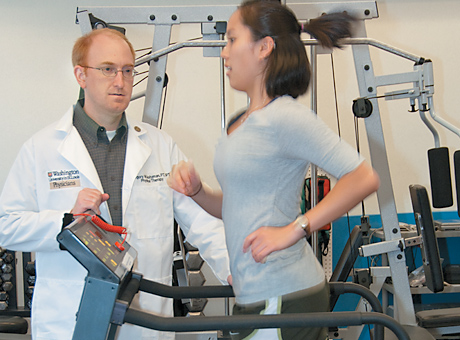
Gregory W. Holtzman, DPT, works with a runner in the Program in Physical Therapy Running Clinic.

Gregory W. Holtzman, DPT, works with a runner in the Program in Physical Therapy Running Clinic.
Running puts extra demands on a person’s feet, legs and rest of the body. Running with any kind of abnormal movement may tack on even more stress, leading to pain or injury.
To help runners reach their potential, the Program in Physical Therapy at Washington University School of Medicine recently launched a running clinic to diagnose movement problems and promote the most efficient running mechanics for each runner.
Gregory W. Holtzman, DPT, assistant professor of physical therapy, developed the clinic using Washington University Physical Therapy’s expertise in movement in conjunction with video technology that provides runners with an in-depth analysis of their running styles.
“Runners tend to fall in a cycle of run, get pain, rest, then run, get pain again and rest again,” Holtzman says. “The reason they keep having pain is they are returning with the same running mechanics. If they don’t do anything to change the mechanics, they will continue to stress specific areas of their bodies. We hope to help them break that cycle.”
Holtzman will operate the clinic with physical therapy colleagues Judith R. Gelber, DPT, and Ryan DeGeeter, DPT. Marcie Harris Hayes, DPT, will lead the research arm of the clinic.
Since running is a results-oriented activity, some runners may imagine themselves crossing a finish line or losing weight more than focusing on proper running mechanics or following a training plan, DeGeeter says.
“We are here to educate patients on running mechanics and training so that they may begin or continue to enjoy the benefits of running with limited side effects,” he says.
Gelber says running can cause stress on the body because of a period of “double float” where neither foot is on the ground, causing the runner to land on the ground with each step.
“The force of running is about three times body weight, and it takes twice as much range of motion at your hip, knee and ankle compared with walking,” she says.
Gelber often sees a pattern of movement that coincides with a runner’s pain, and that pattern is different in every runner.
“When you consider how many strides a runner takes during a single run, all of those repetitions add up,” she says. “This is a different mechanism than a soccer or basketball player, who changes directions and has more random movements.”
The clinic isn’t a training program or personal coaching, Holtzman stresses.
“Our area of expertise is mechanics, and we will help the runner to run their way,” he says. “I don’t have a theory that everyone should run the same way. I’m going to have them run in a way that’s best for them.”
Runners coming to the clinic have 60- to 90-minute sessions with Holtzman, Gelber or DeGeeter, who will provide thorough musculoskeletal evaluations to determine any impairments in muscle length, strength and mobility. The therapist then provides a custom home exercise program to address impairments.
Next, the therapist will videotape runners on a treadmill. The video will be taken from the front, back and each side to pick up any other movement problems. Then, the therapist and the runner will watch the video together, both at regular speed and in super-slow motion, to look closer at any problems.
“Based on the video, we try to connect the movement impairments in the evaluation with the abnormal running mechanics that we see from the treadmill run, then provide a correction,” Holtzman says. “From our perspective it’s not enough to only give exercises. Participants may need to change something about the way they run.”
Holtzman says runners who have already come to the clinic say they have benefitted from seeing themselves on video.
“Video is hugely informative to runners, because they don’t necessarily understand when I say, ‘You’re turning your leg in,’ or ‘You’re not getting a strong pushoff.’ But when I can show it to the patients, they get it.”
Following the initial evaluation, patients can expect two to six follow-up visits over the next several months.
Patients must have a referral from a licensed health care provider to participate in the running clinic, which is located in the Program in Physical Therapy clinic at 4444 Forest Park Ave., Suite 1240, St. Louis, MO 63108. For more information, call (314) 286-1940.